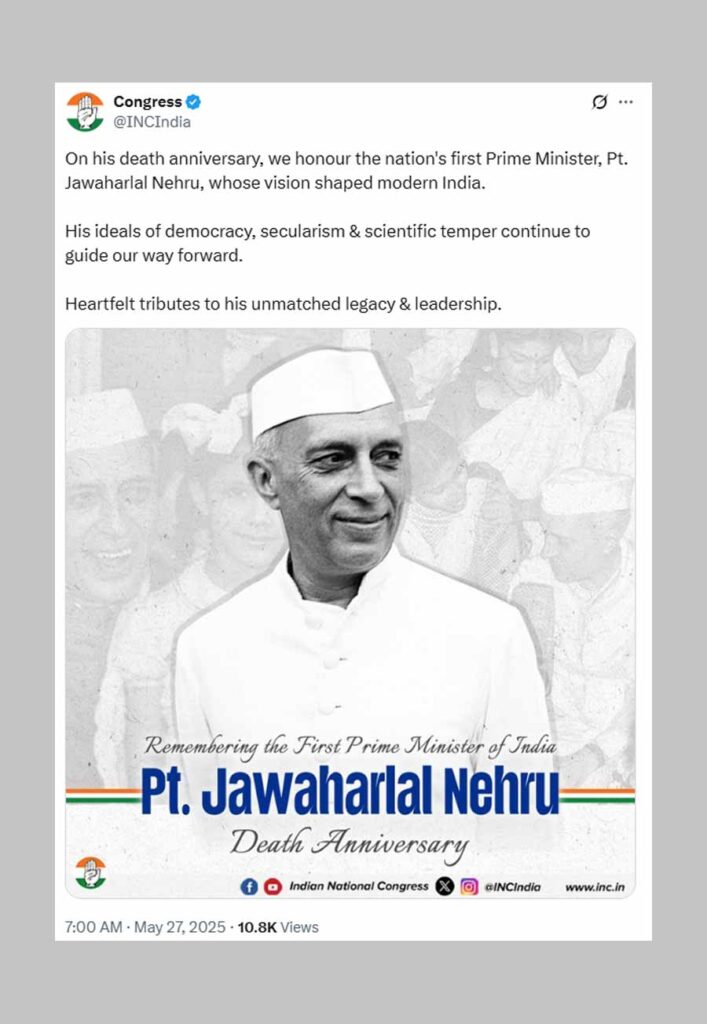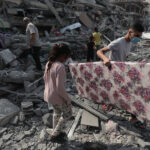On May 27, 1964 at 1.44 PM, India’s first Prime Minister and one of the best chroniclers of this great nation’s history breathed his last at his residence Teen Murti Bhavan. Nehru along with Indira Gandhi came back to Delhi on May 26 afternoon after a three day holiday in Dehradun. Nehru had not been keeping well since his last stroke at the Bhubaneswar session of AICC in January of 1964. After a short rest, the 74 year old Prime Minister, took to his normal schedule despite the requests by his panel of doctors to go slow. For Nehru, work was worship, and when he was not doing official work, he was reading.
On May 26 evening, Nehru was not feeling well. His Dehradun holiday failed to beef up his energy. He went to bed unusually early. He woke up several times at night and before dawn on May 27, he had again pain in the chest. Nehru’s servant Nathuram immediately informed Indira Gandhi and Dr. Bedi, Nehru’s personal physician who had been staying at Teen Murti in nearby rooms since the last stroke of Nehru in January. When the doctor and Indira came rushing, Nehru was still conscious, though disoriented. He asked in a faint voice ‘What is the matter?’ Dr. Bedi carried out all the investigations and found out that Nehru’s aorta had burst. Dr. Bedi took immediately blood from the standing Indira who had the same blood group as her father and transfused it to revive. But Nehru was incomplete coma. Dr. Bedi indicated to Indira that very little chances of survival were there.
Nehru was in coma for few more hours and all other efforts failed. Indira got the hint that that the end was nearing. She along with the people at the PM’s residence informed all the relations and the senior political leaders of the Congress about the status of health. As soon as officially Nehru was declared dead in the afternoon, the issue of a proper funeral with assured security came up. While the officials including the security agencies tried to make the arrangements foolproof, Indira Gandhi faced a big dilemma on choosing whether it would be performed as per Hindu rituals or as per the wishes of her father who wanted a burial without any religious rites.
In his Will dated June 21, 1954 at the age of 64, Nehru wrote candidly that he wanted his funeral rituals to be observed without any religious rites. He wrote “When I die, I should like my body to be cremated. If I die in a foreign country, my body should be cremated there and my ashes sent to Allahabad. A small handful of these ashes should be thrown in Ganga and major portion of them disposed in the manner indicated. No part of the ashes should be retained or preserved”. Nehru reminded in his Will “My desire to have a handful of my ashes thrown in the Ganga in Allahabad has no religious significance, so far as I am concerned, I have no religious significance in the matter”.
Indira was aware of his father’s wish expressed in the Will. He was loyal to her father and shared his worldview and secular values .For the next few hours, it was an agonising period for Nehru’s daughter. The Kauls of Nehru dynasty, the Kashmiris pandits, despite their liberal education and forward looking approach could not reconcile to Nehru’s wish to avoid the Hindu rituals in the funeral scheduled for next day. There was a big pressure on Indira from the senior members of the family to opt for the Hindu rituals ignoring the will of Nehru. It was just not family members, seniors of the Congress Party also advised Indira to go fora normal religious Hindu ritual in the interests of the Party. They said that Nehru’s funeral without religious rites, would not go well with the countrymen, 80 percent of whom are Hindus.
Indira, at personal level, was still ready to defy the family pressure and abide by Nehru’s wish, but the combined pressure of the Nehru family seniors and the veterans of the Congress Party tilted her decision finally in favour of opting for Hindu rituals. After all, she was a senior leader of the Congress Party and had possibility to emerge as the future Prime Minister which she did in 1966 after the sudden death of Lal Bahadur Shastri. There was little time for her delaying the decision on rituals. She gave the green signal late afternoon. It was clear in the evening that India’s first Prime Minister would be cremated as per the Hindu rituals.
During the evening of 27 May, Indian Army engineers prepared a cremation ground, levelling a plot of land situated near the Yamuna River about 300 yards north of the Raj Ghat and constructing a link road from the main road leading to the area. From 18:00 that evening until the following morning, flag officers representing the Indian Armed Forces maintained a constant vigil by the body of Nehru while it lay in state, rotating every hour.
On the morning of 28 May, Nehru’s body, draped with the national flag, was placed on a ceremonial gun carriage by six pallbearers representing the Indian Armed Forces, with two officers from each armed force. The army officers were placed at the front of the bier to place Nehru’s body onto the gun carriage which was then drawn through the streets of Delhi by three groups of servicemen, one each from each armed services.
Nehru was cremated by Hindu rites. The cremation took place at Shantivan. The samadhi in the form of a large base covered with a lawn is located north of Raj Ghat, the Samadhi of Mahatma Gandhi on the banks of the Yamuna, witnessed by 1.5 million mourners who had flocked into the streets of Delhi and the cremation grounds.
At the cremation ground, seven senior military officers (Major Generals D. B. Chopra, S. P. Vohra and R. N. Batra from the army, Captains K. K. Sanjana and V. A. Kamath from the navy and Air Commodores Hari Chand Dewan and Hrushikesh Moolgavkar from the air force) lifted the bier bearing Nehru’s body from the gun carriage and onto their shoulders. The bearers carried the bier inside the cremation ground, placed Nehru’s body on the funeral pyre and saluted the bier before moving away. The six pallbearers then removed the pall from Nehru’s body before the pyre was lit. Indira’ son Sanjay Gandhi, who rushed to Delhi from his holiday in Kashmir after getting the news, lit the pyre. The maker of modern India was finally turned into ashes which were dispersed into the Ganga and Himalayas as per the wishes of Nehru. (IPA Service)

 Unhindered Israeli Killings In Palestine Have To Be Stopped Right Now
Unhindered Israeli Killings In Palestine Have To Be Stopped Right Now 